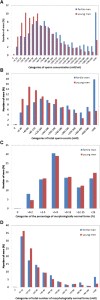Semen quality of 1559 young men from four cities in Japan: a cross-sectional population-based study
- PMID: 23633418
- PMCID: PMC3641477
- DOI: 10.1136/bmjopen-2012-002222
Semen quality of 1559 young men from four cities in Japan: a cross-sectional population-based study
Abstract
Objectives: To provide information of semen quality among normal young Japanese men and indicate the frequency of reduced semen quality.
Design: Cross-sectional, coordinated studies of Japanese young men included from university areas. The men had to be 18-24 years, and both the man and his mother had to be born in Japan. Background information was obtained from questionnaires. Standardised and quality-controlled semen analyses were performed, reproductive hormones analysed centrally and results adjusted for confounding factors.
Setting: Four study centres in Japan (Kawasaki, Osaka, Kanazawa and Nagasaki).
Participants: 1559 men, median age 21.1 years, included during 1999-2003.
Outcome measures: Semen volume, sperm concentration, total sperm count, sperm motility, sperm morphology and reproductive hormone levels.
Results: Median sperm concentration was 59 (95% CI 52 to 68) million/ml, and 9% and 31.9% had less than 15 and 40 million/ml, respectively. Median percentage of morphologically normal spermatozoa was 9.6 (8.8 to 10.3)%. Small, but statistically significant, differences were detected for both semen and reproductive hormone variables between men from the four cities. Overall, the semen values were lower than those of a reference population of 792 fertile Japanese men.
Conclusions: Assuming that the investigated men were representative for young Japanese men, a significant proportion of the population had suboptimal semen quality with reduced fertility potential, and as a group they had lower semen quality than fertile men. However, the definitive role-if any-of low semen quality for subfertility and low fertility rates remain to be investigated.
Figures

Similar articles
-
Semen quality of fertile Japanese men: a cross-sectional population-based study of 792 men.BMJ Open. 2013 Jan 25;3(1):e002223. doi: 10.1136/bmjopen-2012-002223. BMJ Open. 2013. PMID: 23355656 Free PMC article.
-
Testicular function in a birth cohort of young men.Hum Reprod. 2015 Dec;30(12):2713-24. doi: 10.1093/humrep/dev244. Epub 2015 Sep 25. Hum Reprod. 2015. PMID: 26409015
-
Semen quality of young adult ICSI offspring: the first results.Hum Reprod. 2016 Dec;31(12):2811-2820. doi: 10.1093/humrep/dew245. Epub 2016 Oct 5. Hum Reprod. 2016. PMID: 27707840
-
Male fertility potential in terms of semen quality: a review of the past, a study of the present.Fertil Steril. 1979 Feb;31(2):103-16. doi: 10.1016/s0015-0282(16)43808-2. Fertil Steril. 1979. PMID: 367823 Review.
-
Semen quality of Asian men.Reprod Med Biol. 2007 Nov 7;6(4):185-193. doi: 10.1111/j.1447-0578.2007.00184.x. eCollection 2007 Dec. Reprod Med Biol. 2007. PMID: 29699277 Free PMC article. Review.
Cited by
-
Fetal Programming of Semen Quality (FEPOS) Cohort - A DNBC Male-Offspring Cohort.Clin Epidemiol. 2020 Jul 17;12:757-770. doi: 10.2147/CLEP.S242631. eCollection 2020. Clin Epidemiol. 2020. PMID: 32765110 Free PMC article.
-
Dioxins in the semen of men with infertility.Environ Sci Pollut Res Int. 2015 Oct;22(19):14566-9. doi: 10.1007/s11356-014-3109-z. Epub 2014 Jun 5. Environ Sci Pollut Res Int. 2015. PMID: 24894758
-
Assessing the reproductive health of men with occupational exposures.Asian J Androl. 2014 Jan-Feb;16(1):23-30. doi: 10.4103/1008-682X.122352. Asian J Androl. 2014. PMID: 24369130 Free PMC article. Review.
-
An independent validation study of three single nucleotide polymorphisms at the sex hormone-binding globulin locus for testosterone levels identified by genome-wide association studies.Hum Reprod Open. 2017 Jun 14;2017(1):hox002. doi: 10.1093/hropen/hox002. eCollection 2017. Hum Reprod Open. 2017. PMID: 30895971 Free PMC article.
-
An update on semen quality among young Finnish men and comparison with Danish data.Andrology. 2019 Jan;7(1):15-23. doi: 10.1111/andr.12550. Epub 2018 Sep 24. Andrology. 2019. PMID: 30251363 Free PMC article.
References
-
- Fisch H, Goluboff ET, Olson JH, et al. Semen analysis in 1283 men from the United States over a 25-year period: no decline in quality. Fertil Steril 1996;65:1009–414 - PubMed
-
- Vierula M, Niemi M, Keiski A, et al. High and unchanged sperm counts of Finnish men. Int J Androl 1996;19:11–17 - PubMed
-
- Jørgensen N, Andersen AG, Eustache F, et al. Regional differences in semen quality in Europe. Hum Reprod 2001;16:1012–19 - PubMed
-
- Jørgensen N, Carlsen E, Nermoen I, et al. East-West gradient in semen quality in the Nordic-Baltic area: a study of men from the general population in Denmark, Norway, Estonia and Finland. Hum Reprod 2002;17:2199–208 - PubMed
-
- Punab M, Zilaitiene B, Jørgensen N, et al. Regional differences in semen qualities in the Baltic region. Int J Androl 2002;25:243–52 - PubMed
LinkOut - more resources
Full Text Sources
Other Literature Sources
